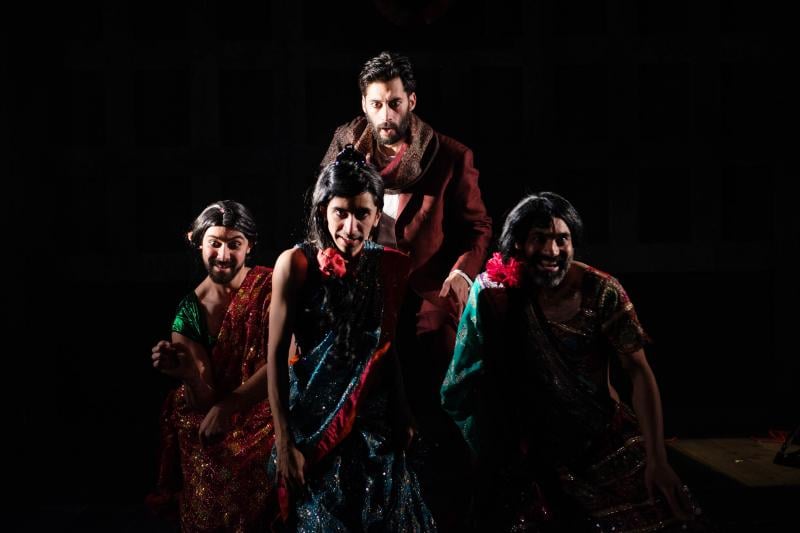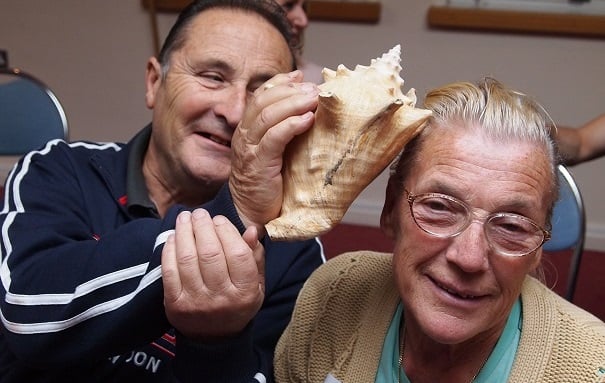
Emmanuel Kojo and company in Show Boat, Sheffield Theatres
Photo: Johan Persson
Arts diversity: To shame, or not to shame
In the fourth of a series of articles, Christy Romer says it’s time for data about workforce, programming and casting to be published openly.
Shame.
Is it ever OK to ‘shame’ an arts organisation? What if its workforce is 2 or 3% Black and Minority Ethnic (BME), while the UK average is 13%? Does this change if it’s based in an ethnically diverse city? If it receives a relatively small amount of public subsidy? If its audiences, programmed work, partner organisations and remaining workforce are diverse in other, or similar ways?
In a comment piece responding to data released by Arts Council England (ACE) last year, The Yorkshire Post memorably decided it was, lumping Hull Truck Theatre, Sheffield Theatres, York Theatre Royal, Harrogate Theatre and West Yorkshire Playhouse together under the heading ‘League of Shame’. It said: “The Arts Council this week published a report on diversity in our theatres. It found 12 theatres in the UK have work forces with fewer than five percent from ethnic minority backgrounds. Five of the 12 are from Yorkshire.
“We have a problem.”
Justified or not, the article raised an interesting question: is it fair for one aspect of an organisation’s work to tar the rest? And, equally, can the sector become more diverse and inclusive by ‘naming and shaming’?
Context is everything
I put all of this to the theatres named by the Yorkshire Post, and received strikingly similar replies.
David Bown, Harrogate Theatre’s Chief Executive, accepted that there is an “awful amount of progress still to be made”, and said he didn’t mind the release of Arts Council England (ACE) statistics “because it’s a starting point and they generate debate and that allows for reflection and ultimately progress”. But he added context: “The figures in the ACE returns – a ‘numbers in boxes exercise’ – include no cohesive narrative around those figures, the work in our community and of that on the stage. We co-produce with Tamasha Theatre Company and we have an associate theatre company Kala Sangam (a South Asian Arts Development Organisation) for example, but that practice goes unregistered in the numbers, because we don’t employ the creative staff.”
Hull Truck Executive Director Janthi Mills-Ward said she was “torn” by the Yorkshire Post article, ultimately concluding the data had a positive impact, but added that her theatre only recruited for one or two vacancies in the years covered by ACE’s workforce data: “Me and Mark (Babych, the Artistic Director) started in 2013 and it was a really tricky situation. Hull Truck Theatre was the second-lowest-funded producing theatre, we were in the middle of having to make massive changes, including a re-structure. At that point we had to prioritise building the financial stabilization of the theatre which unfortunately meant it is only now we have the resources to make the important changes needed to ensure the organisation has a truly representative and inclusive workforce.”

Liz Wilson, Chief Executive of York Theatre Royal, said one person’s story is “not necessarily applicable” to another organisation, but said she personally found the release of data to be useful. Damian Cruden, Artistic Director at the theatre, agreed: “You’ve got to have something that says, ‘this is where we’re at’. The margin for error is going to be a little bit crude, but it’s not going to be so off the beat that it’s invalid. We’ve become more engaged with how we monitor those parts of what we do.”
West Yorkshire Playhouse (WYP) raised similar points. As did Sheffield Theatres. All recognised the worth of having an open debate, centred around figures, and pointed to positives that had been swallowed up by data and comment presented without context. Sheffield Theatres has worked with Act for Change, Tonic Theatre, and Eclipse Theatre. Hull Truck has just employed Director Amanda Huxtable as Artistic Associate through ACE's Change Makers scheme. York Theatre Royal has its TakeOver festival, in which young people take control of programming in the main house for a week, and recently redeveloped the building to increase access. West Yorkshire Playhouse has a raft of initiatives – it was the originator of the dementia-friendly performance and was the country’s first ‘Theatre of Sanctuary’ for refugees – and joins Sheffield Theatres as part of the inclusive disability project Ramps on the Moon.
These successes matter. But regardless of how good your older person’s programme is, or the fact that you’ve collaborated with leading diversity campaigners, or that your artistic programme is diverse and culturally relevant, there’s still a public conversation to be had if only 5% of your publicly-funded arts organisation is BME, yet you operate in a city which is 20% BME. Ditto for an organisation with 23% BME staff in a 48% BME city – or for arts organisations that fail to reflect any aspect of their public’s diversity. As actor and director Jamie Beddard said, “I don’t know about naming and shaming. What I do know is that if you are in receipt of public money, you have a responsibility to reflect and represent the public. If you don’t, this money should be taken away.”
Recognition
But it’s not as if any of the ‘shamed’ theatres refuse to recognise this. “Figures for our permanent staff are broadly moving in the right direction, and we now have 5% disabled staff and 5% BME,” WYP’s Artistic Director, James Brining, said. “Is that good? It’s better than 0% and 4%, but it’s not good enough as far as I’m concerned. A bare minimum as a goal would be equal representation, so when you walk in from the street you don’t notice a difference between one environment and the other.”
WYP even produced figures on the number of BME / disabled actors and permanent staff employed since the Yorkshire Post article was released in December 2015, cautioning that official data could be misleading as forms about ethnic background or Deaf and disabled status were not filled out by everyone. Brining worked on two shows up to August 2016, ‘Chitty Chitty Bang Bang’ and ‘Into the Woods’. In practice, 29 out of 114 people performing in these were BME and / or disabled – though data from official forms alone would be likely to show a smaller proportion.
| “I do think naming and shaming can be useful, if the figures are used intelligently. It’s difficult though because people may not say that they’re disabled for a whole host of reasons.” – Michèle Taylor, Director for Change, Ramps on the Moon project |
Sheffield Theatres’ Chief Executive Dan Bates said: “I think the best organisations are ones where the company’s diverse, the work is diverse, and audience is diverse. And I think some organisations are really good. We’re starting to see the benefits of our work in 2 out of 3 of these areas and our ambition is to see significant change in all three.
“What we have done initially is to focus on our work on stage, to make sure the work presented to our audiences is more diverse. That leads into developing audiences, which can then lead into opportunities to apply to work here. It’s not going to be an overnight fix. If you look at our Sheffield Peoples’ Theatre, we’ve managed to increase the diversity of the company and the people who work on those shows from 5% to 20%.”
York Theatre Royal’s Liz Wilson said: “We earn 80% of our turnover now, which is a huge sum. Every single piece of theatre we make has to make a financial contribution to our overheads. But what that’s an argument for is an argument for diversity. As soon as your business plan has to be about engaging with as many people as you possibly can, it is not an argument for a safe mainstream programme of work. You cannot think that a narrow audience will suit you culturally or economically.”

Harrogate’s David Bown said: “With regards to our permanent staff, which is the area the Arts Council focused on, we have a very small turnover. It can be as little as one person every two years. It’s also very difficult to attract people from other parts of the country, even for acting jobs, and that’s something we need to look at. That’s our responsibility.”
Name, no shame
These nuances are not lost on the wider sector. Purni Morell, Artistic Director of the Unicorn, had sympathy for the difficulties of casting in an era in which not enough non-white actors are being trained: “Sometimes you end up casting a white actor because everyone else you saw, everyone who auditioned, is unavailable or turns you down. We often call 15 people before someone accepts a part. But you can plan, you just need to not leave it so late. I’ve often been unable to find an actor of colour for a show starting rehearsals next day, but if you start your casting 6 months ahead, of course you have more options.”
Similarly, she recognised the difficulties in casting in different parts of the country – an issue that afflicts the smaller, less diverse regions: “It’s not that easy to cast if you’re in parts of the North, say, because so many people would rather work in London. I know lots of directors who cast as well as they possibly can but who still can’t get the people they want to say yes.”
Whilst some people interviewed for these features thought a ‘naming and shaming’ approach was the right way to go – referencing the static nature of the diversity conversation in recent memory – most felt that an ideal scenario would be one in which it would be possible to ‘name’ without ‘shaming’. National Theatre Artistic Director Rufus Norris said: “I don’t think that any meaningful change can be driven by shame alone, but there is a degree to which we need to be open about where we are, and as an industry we have got to be able to start actually publishing figures as part of that commitment.”
This view was echoed by Director Elizabeth Freestone: “It's less about naming and shaming and more about honesty and openness. Publishing data moves the dialogue forwards. Change is not going to happen gradually, or through osmosis, or through a particularly spiky individual. I can feel the restlessness in the industry.”
Similarly, Artistic Director at Derby Theatre, Sarah Brigham, said: “I wouldn’t attack any individual artist or producer. ‘Calling it out’ and a ‘blame culture’ is not useful. Until you’re in a venue and you understand the pressures, the needs etc., it’s really hard to comment on other people’s decisions. You can’t make sweeping claims that something is wrong. Plus I don't get it right all the time, so why would I be casting aspersions?”
If not you, then who
When faced with such responses, it’s hard to locate to the much maligned ‘gatekeeper’ often identified as the stumbling block to true diversity. If, for instance, an Artistic Director can be aware of problems, but liberated from responsibility, who is to blame? Executive Directors? Boards? Casting Directors? Audiences? Without meaning to, diversity and associated challenges become a vague, amorphous problem, visible to everyone but impossible to pin down.
| “When I started working as an actor with companies like The Blahs, it was just taken as a given that there would be people from all different backgrounds represented in our plays and working together. But it seems like the mainstream are only just catching up with these basic concepts that companies who make work in schools have been doing for years.” – Sarah Brigham, Derby Theatre |
Respect for context shouldn’t liberate individuals from responsibility, and a freedom from shame shouldn’t mean a freedom from potentially uncomfortable conversations. The Yorkshire Post’s article – while not the fairest way of having the conversation – forced some, including Hull Truck’s Janthi Mills-Ward, to recognise this: “One of the areas where we absolutely admit that we are on a journey is with casting; we admit that in 15/16 our casting of people from ethnic minority backgrounds and people with disabilities was limited and that needs to be addressed head on. The [Yorkshire Post] article really made [Artistic Director] Mark [Babych] think about the programming and what he puts on.”
Dan Bates, Chief Executive of Sheffield Theatres, said: “Sometimes we’ve programmed incredible seasons, and you check yourself and think – that’s all amazing work, but actually, where’s the BAME creative team members? Is it very male? The diversity conversation is making us think differently and cast our nets wider.”
Open up
The worry, in 2016, is that for all of the good words and actions above – for all of the collaborations, partnerships, programming and pro-active casting – allowing these issues to remain below the radar may result in a situation in which organisations are periodically reminded of the need to act, but systemic inequality remains unaddressed. Arts organisations, like all publicly funded organisations, must be reminded about their shortcomings. This is where the release of data about casting, programming and workforce can help: it would become plain to everyone where diverse work is thriving, and where it isn’t. Elizabeth Freestone called for a centralised database of information about how arts organisations are performing. “It’ll be completely liberating and help to get rid of the guilt. It’ll become fine to say ‘we didn’t do as well on XYZ, but we did do well on ABC’.”
Hull Truck’s Janthi Mills-Ward seemed to agree. “I think being open about arts funding and the difference organisations are making is really great,” she said. “There are conversations to have across organisations. It’s not beneficial for us all to do the same thing or support the same people, it’s about a catalyst of voices. How we’d perform against how Birmingham would perform is completely different because our cities are completely different. And if we’re at the bottom of one league and the top of another, that’s not useful. But celebrating our strengths, which might be different to another organisation, is.”

York’s Damian Cruden took a similarly measured approach: “It would be better to discuss sharing ways forwards. What worked for your company? What changed what you’ve done? How can we implement that? We need to encourage people to be confident about change. If other organisations say, ‘In 18 months you will have turned the corner, and it will make a positive contribution to your organisation’, then that’s hugely important and positive.”
But he added: “The good thing about figures is it prods you to make change. Unless you have those moments in time that are a prod, it is easy to slip into a sense of general ease about it, where it doesn’t matter too much, or a ‘yeah, it’ll do’ – all these easy ways of making it go away. You’ve got to have something that prods you.”
In this context, whilst ACE is to be applauded for releasing NPO workforce figures, it’s a pity that the upcoming diversity ‘ratings’, for which NPOs will or will not be admitted into the portfolio, will only be published on an aggregated basis.
Organisations can play a role in fixing this. Releasing data – away from the glare of shame – would benchmark progress, show that the arts sector is characterised by openness and a public commitment to change, and encourage consistent reflection. As Director Sarah Brigham said: “I think it’s good to start with: ‘I’m not doing enough, because if I was, the world would look different’ – then go from there”.
Christy Romer is a journalist at ArtsProfessional.
Inset photo 1: Tara Arts/ Macbeth – Harrogate Theatre
Inset photo 2: ‘Our Time Session’, a dementia friendly session for participants and their friends and family – West Yorkshire Playhouse
Inset photo 3: Educating Rita (2016) – Hull Truck Theatre
Click to read ArtsProfessional’s latest news, research and features on diversity in the arts
Join the Discussion
You must be logged in to post a comment.